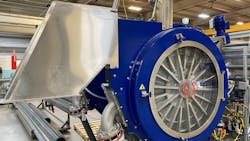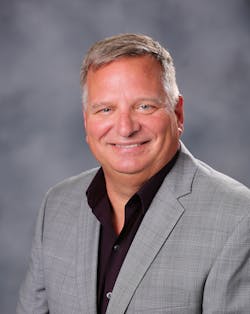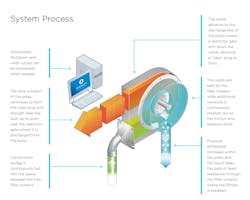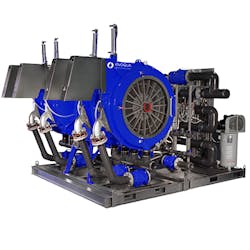Get the Most out of Your Dewatering Program
Municipal wastewater treatment plant operators have several choices when selecting dewatering equipment. In recent years, many experts at Evoqua Water Technologies have prioritized rotary presses in their dewatering portfolios. In the following Q&A, Michael Jager, a senior product manager for Evoqua, discusses why he thinks the rotary press is the best option in terms of maintenance, safety and efficiency.
Q: What are the current challenges being faced by facilities with their dewatering programs?
Michael Jager: Attrition is a significant problem for many municipal wastewater facilities. Subject matter experts are retiring and, with their departure, these facilities are losing valuable knowledge built on a lifetime of experience.
Other challenges include a limited footprint for expansion and obsolete dewatering processes. In addition to being very large, traditional dewatering solutions are also complicated to operate, especially when you have fewer personnel, less knowledge, and less expertise. Some of the other big challenges our customers are facing are continually increasing costs. Whether you’re a municipality or food and beverage plant, the cost of doing business is always on the rise.
Being confronted with large transport bills often results in a big “aha” moment for our customers, because they don’t necessarily realize until they start crunching the numbers how much they pay in transport. When we start doing the math and analyzing cost comparisons with a team of dewatering experts, a whole different picture comes to light as to what the actual cost is for transportation.
Q: How can new technology alleviate some of those pain points?
MJ: A really game-changing piece of technology could address both cost and quality by getting the driest sludge with the least amount of operating expenses—and that’s where Evoqua’s rotary press comes in.
This technology can reduce the operator involvement in terms of time setting up the machine, washing the machine, and running the machine. It also requires much less power than other devices; up to 80 percent less power consumption per day.
The rotary press fits in a small area and is completely contained on its own skid: the feed pump, the chemical polymer injection system, and all the valving. Plus, it doesn’t need a whole separate power bank and everything runs on your standard amperage.
MJ: Because of tight budgets, facilities really need to look at what the savings would be for installing new equipment. At the very least, they should have their sludge analyzed by a lab. How dry are they getting it? Do they even know what their dryness is? Do they know how much water they are transferring down the road and putting in a landfill? The heavier the sludge is, the more they’re going to pay at a landfill. So, facilities could save a lot of money with drier sludge.
Another thing to take into consideration is the capture rate, or the amount of solids coming out of the slurry and how clean the water is. Often, facilities are settling for a 70–75 percent capture rate. Because they are a wastewater treatment plant, they figure they can just return the dirty water back to the headworks, but that’s such a waste. Why clean the water over again? This affects your efficiency; the machine isn’t optimized; the whole process is wasteful.
These facilities would benefit from bringing in an expert in to determine whether they have the driest sludge possible and how they can get the cleanest water out of their slurry.
We offer complimentary sludge analysis to actually allow the customer to better understand where they stand. During the height of COVID, we tested samples in our lab, but we are also able to bring a pilot unit to a facility to demonstrate our dewatering solutions on site.
Additionally, the fewer resources, in terms of manpower, a municipal water plant requires to run machinery, the better off they are. With this unit, one operator simply needs to verify the chemicals are right for that day’s run of sludge and then it can be left alone. With mobile alerts, the unit’s alarm will alert the operator if there’s a problem with the incoming slurry, and the equipment will go into a clean-in-place wash water mode for about five minutes and then turn off until an operator can check the issue.
Q. What questions should facilities managers ask when selecting and sizing a dewatering solution?
MJ: If they’re looking for a new dewatering solution, they should be asking the dewatering supplier about the operational cost: What is the capture rate (how clean is the water going to be)? Is it able to be reused? If they can get the water cleaner, it can head right back out of the wastewater treatment plant for disposal or be used as wash water.
For plants worried about size constraints, they should be asking what kind of space is required: How can we fit this into our existing installation? They’ll also want to ask about chemical usage. Another important question: How much wash water is this unit going to use? Because, if you’re using a large amount of water to wash or backflush a unit, all that water will need to be cleaned again.
Operators should also ask about power requirements and how much operator time will need to be dedicated to operating a unit. What are the standard spare parts that could be used? How many years can it run without being rebuilt? If you have to rebuild a belt press or a centrifuge every five to eight years, you’re going to be spending about 75 percent of the capital cost originally invested to rebuild all the bearings and rollers on a belt press or the rotating assembly on a centrifuge — which can’t be done on site; it must be sent back to the factory. It gets very expensive, and that cost tends to be hidden for facility owners.
Q. For facilities that may have a small project or one-time job, are there any temporary options that might be able to keep disposal costs down?
MJ: For temporary capacity, there are lots of options. Rental units are perfect for short-term capacity needs, such as a machine being down for maintenance or rebuild. We can put a rotary press in there for the duration of repairs. WW
To learn more, visit www.evoqua.com
Published in WaterWorld magazine, December 2021.



